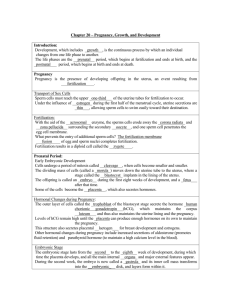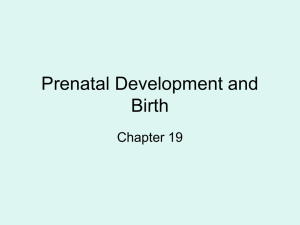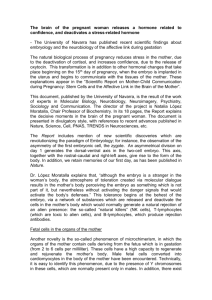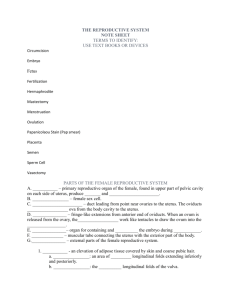ARP11handout6
advertisement
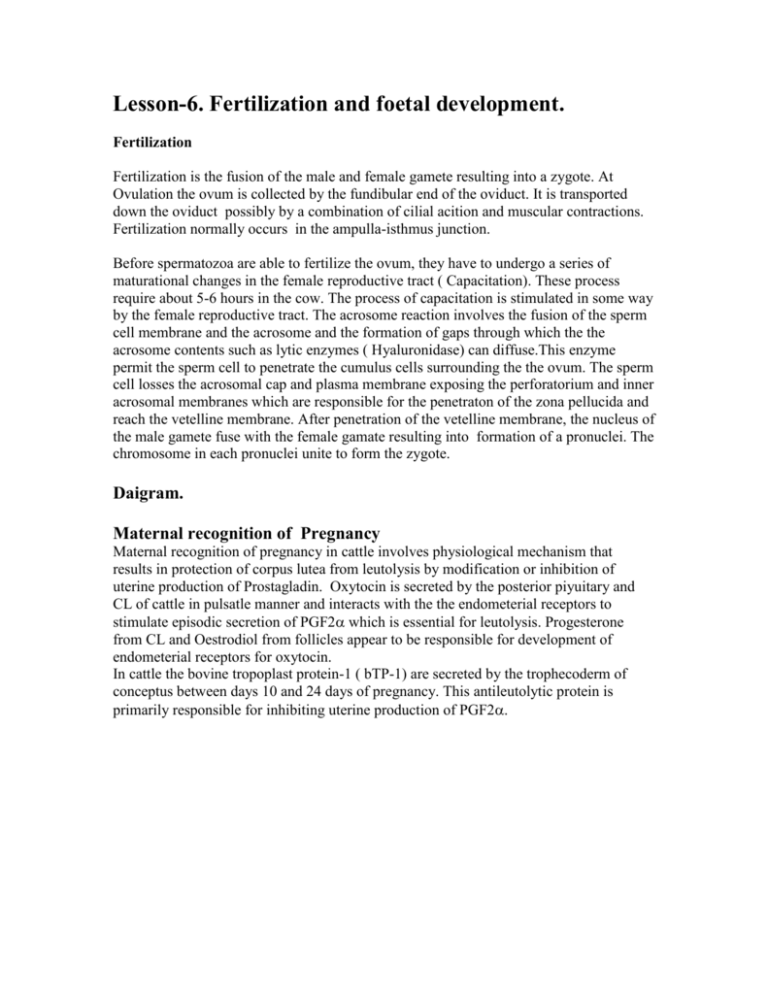
Lesson-6. Fertilization and foetal development. Fertilization Fertilization is the fusion of the male and female gamete resulting into a zygote. At Ovulation the ovum is collected by the fundibular end of the oviduct. It is transported down the oviduct possibly by a combination of cilial acition and muscular contractions. Fertilization normally occurs in the ampulla-isthmus junction. Before spermatozoa are able to fertilize the ovum, they have to undergo a series of maturational changes in the female reproductive tract ( Capacitation). These process require about 5-6 hours in the cow. The process of capacitation is stimulated in some way by the female reproductive tract. The acrosome reaction involves the fusion of the sperm cell membrane and the acrosome and the formation of gaps through which the the acrosome contents such as lytic enzymes ( Hyaluronidase) can diffuse.This enzyme permit the sperm cell to penetrate the cumulus cells surrounding the the ovum. The sperm cell losses the acrosomal cap and plasma membrane exposing the perforatorium and inner acrosomal membranes which are responsible for the penetraton of the zona pellucida and reach the vetelline membrane. After penetration of the vetelline membrane, the nucleus of the male gamete fuse with the female gamate resulting into formation of a pronuclei. The chromosome in each pronuclei unite to form the zygote. Daigram. Maternal recognition of Pregnancy Maternal recognition of pregnancy in cattle involves physiological mechanism that results in protection of corpus lutea from leutolysis by modification or inhibition of uterine production of Prostagladin. Oxytocin is secreted by the posterior piyuitary and CL of cattle in pulsatle manner and interacts with the the endometerial receptors to stimulate episodic secretion of PGF2 which is essential for leutolysis. Progesterone from CL and Oestrodiol from follicles appear to be responsible for development of endometerial receptors for oxytocin. In cattle the bovine tropoplast protein-1 ( bTP-1) are secreted by the trophecoderm of conceptus between days 10 and 24 days of pregnancy. This antileutolytic protein is primarily responsible for inhibiting uterine production of PGF2. Post. Pituitary Ovar y P+ Endometrial Receptor E+ OXY PFF2 leutolysis BTP-1 -VE Conceptus Figure. Schematic illustration of the Mechanism of maternal recognition of pregnancy in cattle DEVELOPMENT OF CONCEPTUS Gestation is arbitrarily divided into three stages as follows. 0-13 days Stage of Ovum, 14-45 days Stage of Embryo 46 until parturition Stage of foetus Stage of Ovum Following the fertilization, zygote begins to divide mitotically,a process known as cleavage and, as a result of peristaltic contractions and ciliary currents in the oviduct, the zygote is propelled towards the uterus and can be found in the uterine horns by day 4. By day five or six, a solid cluster of cells or blastomere known as a Morula is formed. After day 6 the Zygote begins to hollow out to become a blastocyst, which consist of a single layer of cells, the trophoblast with a hollow center and also a group of cells, the inner cell mass at one end. The inner cell mass is destined to become the embryo while the trophoplast provide it with nutrient. Figure. The process of cleavage of the zygote. Stage of Embryo By day 8-9 after fertilization, the zona pellucida begins to fragment and the blastocyst begins to elongate and extend throughout the uterine horn. Development of the germ layers begins from about the fourteenth day. The three germ layers arise from the inner cell mass and are term as Ectoderm, Mesoderm, and Endoderm. The ectoderm gives rise to the external structures such as skin, hair, hooves and mammary gland and also the nervous system. The heart, muscles and bones are eventually formed from the Mesoderm whereas the other internal organs are derived from the endoderm. By day 18 the amnion begins to enclose the embryo By day 22 the heart begins to beat By day 23, the neural groove closes to form brain and spinal cord and head becomes recognizable At the same time the allantois is also well develop Liver becomes prominent and the forelimb buds appear at about 25th day. By 26 day, the embryo becomes curved and tail buds appear. The hind limb buds appear by the 28th day. Eyes and nostril become evident by 30-45 days First Placental plate appear by 30th day and allanto-chorionic sac fill the gravid horn By 33 days fragile cotyledonary attachment develops By day 37,facial features become clear Period of Foetus By day 46-54, the appendages elongate and the eyelid closes by day 60. Bones ossify by day 70-180. By 90th day, hair follicles appear By 110th day, teeth development begins Growth of Hair takes place in 150-220 days Foetal growth is exponential throughout gestation, the rate increasing as pregnancy progresses. Stage of pregnancy ( Months) 1 2 3 4 5 6 7 8 9 Foetal-crown-rump length ( Cm) 0.8 6 15 28 40 52 70 80 90 Development of the extra-embryonic membranes. The embryo is able to exist for a short time by absorbing nutrients from its own tissues and from the uterine fluids but has to depend on the mother for sustenance. Therefore the embryo become attached to the endometrium by means of its membranes and by which nutrients and metabolites are transferred from mother to fetus and vice versa. This attachment is known as Implantation and may begin as early as day 20 days and is completed by day 40-45. The attachment to the endometrium of the mother is achieved through the development of foetal membranes. The Yolk sac is formed as an outpouching of the developing gut. It is separated from the uterine wall only by the outer layer of the blastocyst and it readily absorbes nutrients. The yolk sac serves to transfer nutrient from the uterus to the embryo and is only transitory. This role is eventually taken over by the allantoises. The amnion is composed of a layer of mesoderm and a layer of ectoderm which grow up and over the embryo eventually fusing to enclose it in a complete sac. It is usually completed by day 18 and becomes filled with fluid providing support and protection for the developing embryo. The amniotic sac is the so called water bag. The allantois is formed as an out pouching of the developing hindgut. This grows outward eventually coming in contact with the trophectoderm to from the chrion or chorion- allantois. This membrane is well developed by day 23 and eventually surrounds the embryo, amnion and allantoic cavity, becoming densely vasculaized with the vessels branching away from the umbical cord. The allantochorion contacts the uterine caruncles, finger-like processes or villa, containing capillary tufts , grow out from the allantochorion into the crypts of the maternal caruncles, which also are surrounded by capillary plexuses. Thus is formed the characteristic ruminant cotyledon, or placentome, through which the nutritious and gaseous exchange takes place between mother and fetus. There are about 120 functioning cotyledons arranged in four rows along each of the uterine horn. In cattle,the placenta is of cotyledonary type as the villi are grouped into multiple circumscribed areas. Figure. Development of foetal membranes Foetal development. Hormonal changes during Pregnancy. Oestrogen The ovarian follicle development continues during the pregnancy due to low levels of Gonadotrophin secretion. Both ovarian follicles and embryo-plancental unit produces oestrogen. Plasma milk Oestrone sulphate concentrations rise gradually during pregnancy in the cow and their measurement is a means of Pregnancy diagnosis. Progesterone level in plasma and milk rises during the first few days of pregnancy in an identical manner to that occuring in early luteal phase of the non-pregannt cow. Instead of declining from about day 17 , high progesterone levels are maintained throughout pregnancy reflecting the maintenance of CL. Mean plasma level of LH and FSH remain low during pregnancy. Gestation Period of different species of animals. Species of Animals Gestation period ( Days) Cattle 280 +- 5 days Horse 327-357 days Pig 112-115 days Sheep 140-155 days Goat 142-145 days Dog 60-63 days Cat 56-65 days yak 258 days


